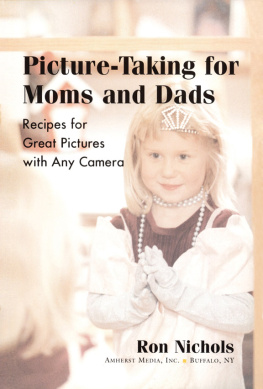PHOTOGRAPHING
YOUR CHILDREN
A HANDBOOK OF STYLE AND INSTRUCTION / BY JEN ALTMAN


Text copyright 2013 by Jen Altman.
All images, unless otherwise noted, copyright 2013 by Jen Altman.
Additional images copyright by the individual photographers.
Illustrations copyright 2013 by Amy Haney.
All rights reserved. No part of this book may be reproduced in any form without written permission from the publisher.
Library of Congress Cataloging-in-Publication Data available.
ISBN: 978-1-4521-2437-7
constitutes a continuation of the copyright page.
Design by Lauren Michelle Smith
Chronicle Books LLC
680 Second Street
San Francisco, CA 94107
www.chroniclebooks.com
ACKNOWLEDGMENTS
Thank you to the wonderful parents who allowed me to photograph their beautiful children. They were such a joy to work with, and Im honored that you allowed them to be a part of this project.
Thank you to my friends and fellow photographers for the work they contributed to this titleI admire what you do so much and am grateful for your time and energy.
Thank you to Amy Haney for her lovely color wheel and f-stop illustrations.
Thank you to Lauren for the beautiful and innovative design of this book.
Thank you to my wonderful editor and friend Bridget Watson Payne.
Thank you to my own parents for the beautiful photographs of my own youth; I treasure them.
Thank you to my husband for so many things, but greatest among them, our lovely daughters.
And thank you to my daughters, whose patience with me and my cameras seems limitless.
CONTENTS

By Irene Nam

By Sarah Wert
INTRODUCTION

INTRODUCTION
Imogen Cunningham, one of the godmothers of modern photography, was once asked which of the many photographs she had taken was her favorite. Her answer was simple, The one I am going to take tomorrow. This wisdom is nowhere truer than when it comes to photographing our own children. As they grow, we try to document each moment, in the hope that we can capture not only their fleeting changes, but their essential natures as well. Parents are notoriously busy, however, and all too often find themselves snapping photographs hurriedly, without much regard for anything but pushing the button and insisting that the child smile beaming back at the camera. The result is not only a lackluster experience for both parent and child, but also an image neither is satisfied withwe often sense a lack of reality in those pictures and a greater need for authenticity. But how to achieve it?
I started photographing my own children for the same reasons most of us doto create a visual record of their lives as they grow. But at some point between the need to shoot and the actual process of doing so, I found that I really, really loved it. That is when everything changed. I realized that not only was I documenting their lives, but also that my workmy photographswere becoming a beautiful tribute to our everyday existence. I worked hard to master light and composition, and when I began to see the results of this work in my shots, I was truly moved. The alchemy of child, light, and composition coming together can create such beauty. And the pleasure is not only in the photograph itself; you should find joy in the process of taking the picture as well. It took some time for me to realize that my children dont always have to smile, they dont always have to look at me, they dont always have to be camera ready.
When I started photographing my girls, I used an entry-level digital single-lens reflex (DSLR) camera. It was a great little workhorse, and I found it very easy to use because I let the camera dictate the settings. Shortly thereafter, I discovered old Polaroid cameras, and they became my greatest teacher when it came to capturing light and learning how to shoot under various conditions. It was shooting film that fostered the desire to have more control over my digital camera. A good friend spent an afternoon with me in her studio, showing me how to shoot manually. This was my true awakening as a photographer. We will spend some time in this book discussing shooting this way and why it makes such a difference in your work. If you have a DSLR, I want to teach you how to really use your camerato switch off that automatic setting for good and shoot confidently in manual mode. I hope that once you do, once you see what you yourself, and not just your camera, are capable of, you will fall in love with this process as much as I have.
This book will focus not only on the fundamentals of taking successful photographs, but it will also encourage you to challenge the preconceived notions of what childrens photography should look like. I want to inspire you to photograph your own children in ways that you will regard as fine art, real and tangible. I want to help you make memories that are not saccharine, but rooted in the authenticity of the everyday. I will also ask you to rethink the idea of portraiture. There has been a popular movement in the last few years away from formal portraits, toward a more casual, in-the-moment, type of photography. Many of us spent too many painful hours in our own youth squirming in stiff clothes at the Sears Portrait Studio. And, consciously or not, we call upon those memories when we visualize how our own childrens portraits might look. But the contemporary idea of portraiture has changed, to a more faithful representation of the childs own unique personality (without the Technicolor backdrop).
To grow as an artist and as a photographer, it is valuable not only to push yourself within the technical limits of your equipment, but also to study the work of both peers and professionals. Much great talent can be found in some of the childrens photography groups on photo sharing sites like Flickr. It may be helpful to see the ways others are shooting and then question or critique that work. Ask yourself why you are drawn to a particular shot. Is it the use of light? The composition? Also look at images by the professionals. Seek out work not only by the masters of photography, but by painters as well. By studying fine art photography and painting you will begin to learn how these artists used light to highlight their subjects, bathing them in ethereal beauty. It may not be apparent at first, but all of this is part of the process of creating a personal style in your work. This will not happen overnight or within weeks. It takes time to cultivate a personal style, and the more you learn about the way you love to shoot, the more you will begin to see your own style emerge. It cannot be forced. Nor can it be simply a reproduction of your favorite photographers work. Rather, it will be a reflection of the intimate bond between you and your child, the magic that sparks between the two of you, captured when you press the shutter. Be open to change, to growth, and to embracing the organic nature of the process. And as you develop your own style of shooting, its important to remember to always shoot for yourself and your child. Grandparents or friends may not understand what youre doing, but they dont have to. As long as you are shooting authentically from your heart, rest assured you are doing the right thing.













